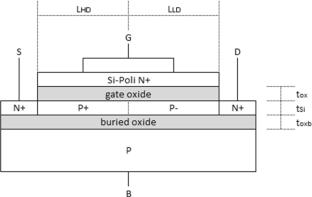非对称自级联码与梯度通道SOI nmosfet跨电容模拟性能比较
IF 2.2
4区 工程技术
Q3 ENGINEERING, ELECTRICAL & ELECTRONIC
引用次数: 0
摘要
本文对具有不同栅极长度的非对称自级联码(a - sc)和梯度通道(GC)绝缘体上硅(SOI) nmosfet的跨电容进行了比较研究。这种分析是通过二维数值模拟来完成的。仿真结果显示了其他跨电容对ASC SOI器件和GC SOI器件栅间电容的影响。本文章由计算机程序翻译,如有差异,请以英文原文为准。

Comparative of analog performance of transcapacitances in asymmetric self-cascode and graded-channel SOI nMOSFETs
This work presents a comparative study of the transcapacitances of an asymmetric self-cascode (A-SC) and graded-channel (GC) silicon-on-insulator (SOI) nMOSFETs with different gate lengths. This analysis was done by means of two-dimensional numerical simulations. Simulated results show the influence of others transcapacitances on the gate-to-gate capacitance for the ASC SOI device and the GC SOI device.
求助全文
通过发布文献求助,成功后即可免费获取论文全文。
去求助
来源期刊

Journal of Computational Electronics
ENGINEERING, ELECTRICAL & ELECTRONIC-PHYSICS, APPLIED
CiteScore
4.50
自引率
4.80%
发文量
142
审稿时长
>12 weeks
期刊介绍:
he Journal of Computational Electronics brings together research on all aspects of modeling and simulation of modern electronics. This includes optical, electronic, mechanical, and quantum mechanical aspects, as well as research on the underlying mathematical algorithms and computational details. The related areas of energy conversion/storage and of molecular and biological systems, in which the thrust is on the charge transport, electronic, mechanical, and optical properties, are also covered.
In particular, we encourage manuscripts dealing with device simulation; with optical and optoelectronic systems and photonics; with energy storage (e.g. batteries, fuel cells) and harvesting (e.g. photovoltaic), with simulation of circuits, VLSI layout, logic and architecture (based on, for example, CMOS devices, quantum-cellular automata, QBITs, or single-electron transistors); with electromagnetic simulations (such as microwave electronics and components); or with molecular and biological systems. However, in all these cases, the submitted manuscripts should explicitly address the electronic properties of the relevant systems, materials, or devices and/or present novel contributions to the physical models, computational strategies, or numerical algorithms.
 求助内容:
求助内容: 应助结果提醒方式:
应助结果提醒方式:


